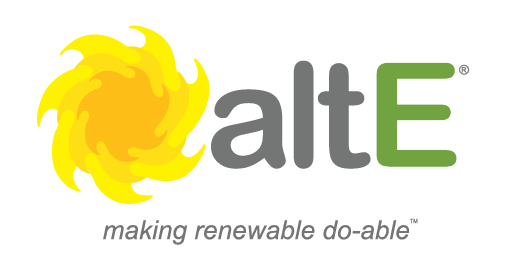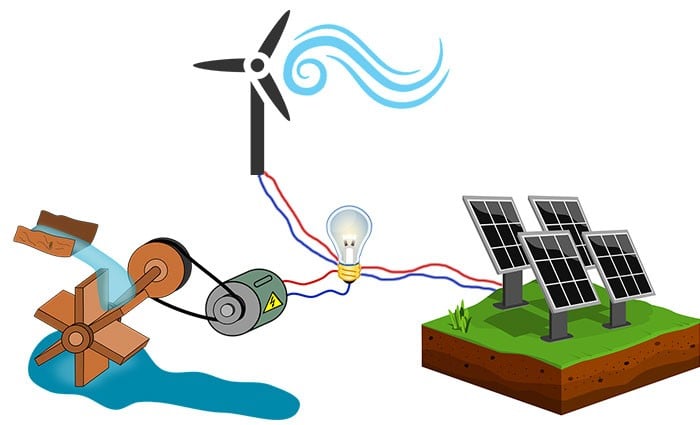Choosing the Right Sources of Alternative Energy for Your Location
Selecting what type of renewable/alternative energy to use to power your home or business is not always about what you would prefer to have but what is best available and economically most feasible. Here we will discuss reviewing your site for its potential in generating electricity from solar power, wind power, and hydro (water) power. We won’t be covering solar air heaters and solar water heaters in this article, which are exceptionally cost-effective for most home owners (we have more information on these technologies in our Other Renewables section).
Ignoring solar heating, and – for the moment – any rebates or tax incentives offered by your local or national governments and assuming that you site had plenty of resources to provide solar, wind or hydro power, the most cost effective systems for generating electricity are (going from least to most expensive):
- Micro hydro electric systems
- Wind electric systems
- Solar electric systems
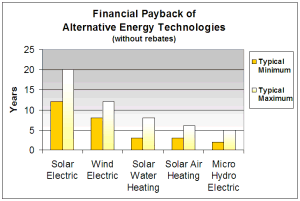
Ironically, the types of systems that are most frequently used go in exactly the opposite order: solar electric systems are most common, followed by wind electric systems and then micro hydro electric systems. The reason for this reversal is due in part to the actual availability of these energy resources, rebates and incentives, zoning laws at particular a location among other things. Fortunately, solar panel (electric) systems have dropped quite a bit in cost too in recent years.
Below we’ll tell you how to assess and size each type of these renewable energy systems (click on the section you want to jump to and learn more about):
Assessing Solar Power Potential At Your Location
Most locations can make use of solar power as long as where you would install the solar panels would have a clear shot of the sun for most of the day (e.g. 9am through 3pm). Most solar electric panels rapidly decrease in performance with just a little bit of shading. Literally the shadow of a small tree branch upon a solar panel could cause it to decrease its output by 30% or more.
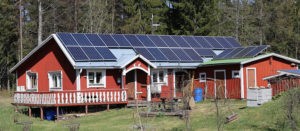
The amount of energy you can get from solar electricity at your site depends on your location in the world and the time of the year. Obviously, sites closer to the equator will tend to receive more solar power throughout the year than ones far north or south of the equator. Generally, sites north of the equator receive more sunlight between the months of April through September, and sites south of the equator receive more during the opposite time of the year (October through March). As you can imagine, sunlight is also affected by the weather. Sites that frequently have long lasting fog or are overcast during large parts of the year will have less available solar power.
The measurement for the strength of the sunlight striking the earth at your location is defined as solar insolation. Using this value, you can determine how much energy you can generate through out the year for your site. Solar insolation data for all over the world and at different times of the year has been investigated and recorded. Here are some links to help you find the solar insolation in your area:
- Worldwide map of insolation and PV potential
- USA map of insolation and PV potential
- List of solar insolation data for U.S. cities
- Mexico, Caribbean, and Central America map of insolation and PV potential
- South America map of insolation and PV potential
To determine the average daily amount of energy you would produce at your location, you would multiply the average annual solar insolation value times the total wattage of your solar panel array. As an example, let’s say that you had a single 100-Watt solar panel and you lived in Columbus, Ohio, which has an average annual solar insolation value of 4.15 sun-hours. To determine your average daily energy output out of that 100W panel you would multiply 100 Watts by 4.15 sun-hours (100 x 4.15), which is 415 Watt-hours (or 0.415 kilowatt-hours). This amount of energy would be about enough to power a TV for a couple of hours every day.
Sizing a Solar Electric System to Fit Your Needs
In reality, the process for determining the size of your solar electric system is the opposite order of what we just went through in the previous example. First, you determine how much energy you need on a daily basis in kilowatt-hours (kWh). This data can be found on your electric bill on a monthly basis if you have one for your location. Otherwise you will need to go through the process of estimating your energy consumption (our load calculator can help with this). To estimate the energy usage on a daily basis, take your monthly estimate and divide by 30.
Second, you need to determine the solar insolation value for your site. If you’re going to be totally disconnected from the electric grid/utility company then you will need to use the minimum (worst case) solar insolation value for your location. If you’re going to be feeding your electricity into the electric grid then use the average solar insolation value.
Lastly, you need to divide your estimated daily energy usage (kilowatt-hours) by the solar insolation value and multiply by an system inefficiency factor:
Total Watts of Solar Electric Panels Needed = [(Daily Kilowatt-hours)/(solar insolation)] x Inefficiency Factor
The inefficiency factor for systems that are disconnected from the electric grid (off-grid) is 1.3. For systems that are connected to the grid (also called on-grid, grid tied, grid intertied or grid connected) that value is usually assumed to be 1.2. The reason that it is higher for off-grid systems is that these systems have to store the energy in battery banks which are not perfectly efficient. Most on-grid systems either don’t use batteries at all or use them in such a way that their inefficiencies are minimized.
Choosing the Right Solar Electric Panels
Now that you know the total wattage of the solar electric panel array you need, it’s up to you select the specific solar panels that will make up this total wattage. For example, if determined that for your home you needed a total of 3500 Watts of solar panels and you found a 370-Watt solar panel you liked, then you would need 10 of them (3500 Watts divided by 370 Watts/panel = approximately 10 panels, rounding up to the next whole number).
People make selections of solar panels based upon many different factors. Some people prefer only larger solar panels because it means they have to do less wiring in interconnecting the panels. Others choose moderate size panels because they’re easier to lift and maneuver. Other people will choose panels based upon color, electric properties, whether or not the manufacturer is a petroleum company, which country the panels are manufactured in, whether the panels are immediately available – and of course price per Watt plays a big role. Review the many solar panels we offer and speak with one of our sales people to help you find the solar panels that will best suit your needs.
Assessing Wind Power Potential At Your Location
The general rules for determining whether your site is suitable for wind power is less complicated than doing it for hydro electric. Generally speaking, you need at least a 1/2 acre (0.2 hectares) of open land where you can mount the wind turbine on a tower, and your average wind speed should average 10 mph (16km/h) either annually or during the months you intend to use the wind turbine.
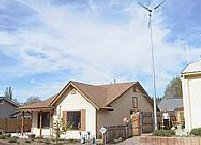
There are several methods for estimating the average wind speeds for your location, some less accurate than others. Here is a list of possible sources:
- Collect data from your own weather station
- Ask a neighbor who has a weather station
- Rate how wind-whipped your vegetation is with Griggs-Putnam index
- Search for local wind records online
- Call local radio/TV station for wind data
- Call a local/regional airport for data
- Review general wind resource maps provided by NREL (if you’re located in the USA) or your national government
When reviewing your location to see if you have at least a 1/2 acre of land available to mount the wind turbine, keep in mind that the tower also needs to extend the wind turbine at least 30 feet above nearby (i.e. within 300 feet (91m)) obstructions such as trees, buildings or hills. These obstructions create turbulence in the air around the causing the wind turbine to work very inefficiently. The turbine needs to get up above the turbulence to smoother air flows.
There are exceptions to these rules of thumb, such as people who would like to use small wind turbines for their boats or RVs. In these cases, the location and weather conditions can vary widely from day to day. Usually, in these applications the turbine is used in conjunction with other power sources such a solar electric panels or a generator to charge up a battery bank.
Sizing a Wind Power System to Meet Your Needs
Once you’ve determined the average winds for your location and determined if you have a suitable location for a wind turbine, you can then select the specific wind turbine to meet your needs. Simply go to the specific page on the altE store website for any wind turbine and look for a chart or table which will tell you how many kilowatt-hours of energy you can expect to product given the average wind speed for your location. If the estimated energy the turbine you selected isn’t enough for your needs, go to larger turbine and see if that will meet your needs.
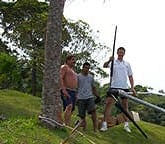
If you find that the turbine you would like to have doesn’t supply the energy you need at the average wind speeds you have for your location, then you have a few options besides going with a larger wind turbine. One option is to consider using a hybrid system. That’s a system that combines two different renewable energy technologies together, such as a wind turbine and a solar electric system. A benefit to a hybrid system is that the two different technologies frequently compliment each other. For instance, when the sunshine is low due to a rainstorm, there tends to be more wind – providing more power to the wind turbine.
Another option is to look again at how you can reduce your energy needs in your home. Are there more creative ways you can come up with to reduce how much electricity is used in your home? Review the EnergyStar website for tips on how to further make your home more energy efficient. Consider buying a book that provides even more tips on how to maximize the energy efficiency of your home. The rule of thumb is that for every $1 you spend on making your home more efficient, you reduce the purchasing cost of the required renewable energy system by $3 to $5.
Assessing Micro Hydro Power Potential At Your Location
It is estimated that only 5% of the population in North America is fortunate enough to have a location suitable for generating micro hydro electric power. To take advantage of this form of renewable energy, you need a river or stream that provides sufficient water flow rate and head. Head is the vertical distance between where you would divert the water to your turbine and where it would re-emerge to be joined back with the original water source. You can have heads as low as 6 feet (2 meters) but you will need to have relatively high flow rates to generate any significant power.
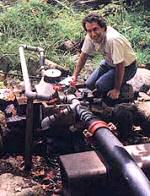
To estimate the amount of instantaneous power (Watts) you could generate from your location multiply the head (in feet) by the flow rate (in US gallons per minute) and then divide by ten:
Equation for estimating power for micro hydro: Head (feet) x Flow (US gpm) / 10 = Output (Watts)
For example, let’s say you had a site which had a head of 60 feet and 100 gallons per minute. Your instantaneous power available would be 60 x 100 / 10 = 600 Watts. This may not sound like a lot of power, however, remember that in most cases the river is flowing all day and all night long. As a result, to estimate the total daily energy being produced you would multiply the 600 Watts times 24 hours, which equals 14,400 Watt-hours. Over the period of a month (~30 days) that would be 432,000 Watt-hours (or 432 kilowatt-hours). This particular scenario would provide enough electricity to power most energy-efficient homes.
Determining flow rate of a stream or a river is usually more challenging than determining the head. One method for determining the flow rate is to see how quickly the stream fills up a bucket of a known volume (e.g. a 5 gallon bucket). For instance, if a five gallon bucket can be filled up in 10 seconds, then you know that over a period of a minute (60 seconds) there would be 35 gallons (5 gallons x 6 re-fills of the bucket in a minute), or 35 gallons per minute (gpm). This method is somewhat challenging as you sometimes need to dam up and divert the stream entirely through a single tube that outputs into your bucket of known quantity.

